A SEARCH
FOR KNOWLEDGE
by Robin Williams,
Somerset, UK
A UK naturalist and photographer describes
how he developed an interest in the gall wasps, bees and ants
found in Southern England. He discusses both the difficulties
often encountered with identifying these insect groups and the
booklets he has written to aid their identification.
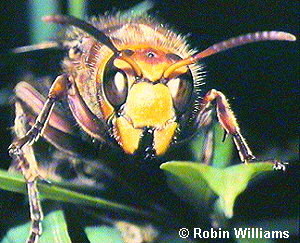 After many years
of abiding interest in watching and photographing birds, I came
back to a very early interest - insects. Partly this was due to
the apparent weight of equipment increasing as my years advanced,
but it also arose through sheer chance. Our local Wildlife Trust
put in a little notice in its newsletter, 'If you are interested
in learning more about dragonflies please contact John Boyd', and
it gave a phone number. It turned out to be a short course, out
in the field, designed to last four Saturdays but has been
running ever since. Ten years later it looks as if it will
continue as long as our little group is still here. (Image right:
Hornet, female, Vespa crabro).
After many years
of abiding interest in watching and photographing birds, I came
back to a very early interest - insects. Partly this was due to
the apparent weight of equipment increasing as my years advanced,
but it also arose through sheer chance. Our local Wildlife Trust
put in a little notice in its newsletter, 'If you are interested
in learning more about dragonflies please contact John Boyd', and
it gave a phone number. It turned out to be a short course, out
in the field, designed to last four Saturdays but has been
running ever since. Ten years later it looks as if it will
continue as long as our little group is still here. (Image right:
Hornet, female, Vespa crabro).
Our group, with six regular members, meets every Saturday
throughout the year and spends the day visiting wildlife reserves
and other interesting spots, largely on the Somerset Levels and
Mendips. Weather has to be pretty poor to deter us and we have
eaten lunch on a Mendip slope in howling winds and even snow.
Mark you, we have learned how to dress comfortably and how to
carry cameras and other equipment in the easiest way.
The interests of the group still include dragonflies, on which
John is a renowned expert, but have grown both more catholic and
more restricted. if that does not sound too strange. We have also
become more knowledgeable as well as being more aware of how
misleading first impressions can be in trying to identify insects
in the field. We are all photographers and take anything which
catches our eye - hence the catholicism of my earlier remark. But
we all came to the conclusion that if you are to know anything
worthwhile, it has to be about a limited range of species. So our
specialities have developed. Two of us have interests in snails,
centipedes and millipedes, though they also wander off after bugs
when they see them. Another has moved away from insects into a
passion for fungi, while a fourth is particularly taken with
Hymenoptera (wasps, bees and ants) as well as mosses. My general
field is Hymenoptera, with a very special interest in the wasps
which inhabit oak-galls, though being a photographer I cannot
resist any beautiful insect.
All this has shown up problems, as anyone who has studied the
lesser-known areas of natural history will be aware. How do you
recognise the creatures you have seen, photographed or caught?
There are almost no books which illustrate all the species of a
particular family or group. The only ones which do exist are for
popular creatures such as dragonflies, grasshoppers and
hoverflies. Everything else depends on whether anyone has
produced keys to a family and, more important, whether you can
understand the strange and esoteric language used in these.
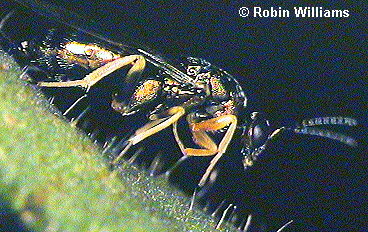 We soon found out
how difficult it was to make an identification from even an
excellent key and also how impossible it was unless you
understood the technical terms in use. As some of the current
keys date from the end of the last century (because no-one has
written a more up-to-date version), it will be appreciated that
language has moved on during that time and there are now several
names for the same part.
We soon found out
how difficult it was to make an identification from even an
excellent key and also how impossible it was unless you
understood the technical terms in use. As some of the current
keys date from the end of the last century (because no-one has
written a more up-to-date version), it will be appreciated that
language has moved on during that time and there are now several
names for the same part.
(Image left: Chalcid wasp, female, Torymus nitens).
Being used to market research in my previous incarnation, I
spent a great deal of time in reading up on those areas which
particularly interested me. The result was two booklets, produced
initially purely for my own benefit and that of the members of
our group, bringing all this information under one heading.
Sources included books, many obscure articles and information by
word-of-mouth. The first booklet was entitled, 'Southern British
Ants, Their Descriptions and Lifestyles'. This is an accumulation
of information from as many sources as possible, but presented in
a quite different fashion to normal. The book refers particularly
to Somerset & Dorset but the findings apply to other parts of
Britain in many cases.
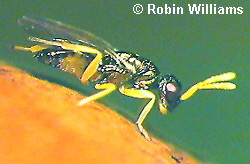 There are no keys
included as such as it is designed to be used in conjunction with
other books for final identification, though some identifications
will emerge naturally from using the tables. The idea was to
produce something which will enable you to go out into a habitat,
find ants and shortlist them down to one or two with
comparatively little effort., though some groups, such as the red
ants, are always tricky. It should certainly make ant watching
much more fun - and they are most fascinating creatures.
There are no keys
included as such as it is designed to be used in conjunction with
other books for final identification, though some identifications
will emerge naturally from using the tables. The idea was to
produce something which will enable you to go out into a habitat,
find ants and shortlist them down to one or two with
comparatively little effort., though some groups, such as the red
ants, are always tricky. It should certainly make ant watching
much more fun - and they are most fascinating creatures.
(Visit ant image gallery).
(Image right: Chalcid wasp, male, Mesopolobus sericeus)
The second book was much more fundamental. For various reasons
I became involved with recording Hymenoptera and had to try and
come to grips with understanding and recognising them as quickly
as possible. Many of the keys are very old, others newer but
sometimes equally difficult to understand. What did the terms
mean? How could I find the answers?
This proved far more difficult than I had imagined. There were
two sets of queries; the first concerning purely technical terms
for the parts of the hymenopteran body - and they often turned
out to have several sets of names for the same part. The second
set were associated with descriptive terms, adjectives, used for
describing general conditions, such as colour, shape and form.
These were equally obscure, the writers of the keys appearing to
have invented their own meaning for some words in use under
different meanings elsewhere. Even the multi-volume Oxford
Dictionary did not have all of these in its pages. Some
professionals, who might have been expected to use these terms in
their everyday work, turned out not to understand them. But, if I
was to follow the keys, I had to find the
answers.
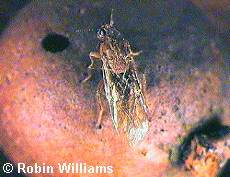 Eventually I
found many of the answers and built them into another booklet, 'British
Hymenoptera, Glossary for use with Identification Keys',
which has changed its content and even its title in the several
editions it has gone through. Everyone who has had one has been
asked to point out mistakes or tell me about terms not covered
which have baffled them in using keys to Hymenoptera. This has
been enormously useful and the latest version covers nearly twice
as much as the first, with nearly 300 technical terms for body
and wing parts and around 250 descriptive terms. Separate
sections deal with cuticular microsculpture - the sculpting of
the surface of the body - and colour, with drawings to illustrate
basic divisions and parts. If you need to use keys to
Hymenoptera, this will clear up the basic understanding of what
the author meant. It will no longer look like gobbledygook - as I
thought the first time I tried to use one such key. (Image right
above: Marble gall wasp, female, Andricus kollari).
Eventually I
found many of the answers and built them into another booklet, 'British
Hymenoptera, Glossary for use with Identification Keys',
which has changed its content and even its title in the several
editions it has gone through. Everyone who has had one has been
asked to point out mistakes or tell me about terms not covered
which have baffled them in using keys to Hymenoptera. This has
been enormously useful and the latest version covers nearly twice
as much as the first, with nearly 300 technical terms for body
and wing parts and around 250 descriptive terms. Separate
sections deal with cuticular microsculpture - the sculpting of
the surface of the body - and colour, with drawings to illustrate
basic divisions and parts. If you need to use keys to
Hymenoptera, this will clear up the basic understanding of what
the author meant. It will no longer look like gobbledygook - as I
thought the first time I tried to use one such key. (Image right
above: Marble gall wasp, female, Andricus kollari).
The third work is more ambitious in its scope and the research
contained within it. Some years ago Margaret Redfern & Dick
Askew produced a book in the Naturalists Handbook series, 'British
Plant Galls', which transformed the study of these
fascinating vegetable growths. Our group became instantly
fascinated by galls and the insects which caused them and were
parasites within them. Almost immediately, I decided to
concentrate upon the study of galls on oaks in Britain and have
been pursuing this ever since. In course of time it is hoped that
the study will cover all 68 oak galls and their 130 odd
inhabitants - though even these figures may turn out to have been
incorrect by the time the study is completed, for new insects and
galls are still being found. Much of this work is well under way
but the first fruits of it are contained in, 'The Oak
Marble-gall in Britain, with keys, descriptions and drawings of
its Inhabitants'. This, covering just one of the
oak-galls, is very much aimed at the amateur, with easy to follow
diagrams, jargon-free descriptions and a clear picture of how to
find, understand and recognise the inhabitants.
The Oak marble-gall is a brown, spherical growth between 10
and 20mm in diameter, commonly found on the end of twigs on our
native Pedunculate and Sessile oaks. The gall is formed from
peculiar cell growth excited when a cynipid wasp larva hatches
from an egg laid in the bud. But the extraordinary thing is that
this gall may contain up to 19 different species of wasps. The
history is made even more bizarre in that while this gall is
produced by an asexual generation of wasp, a completely different
gall, on another species of oak, is produced by the next, sexual
generation of the same wasp.
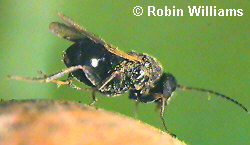 How about the 19
different insects which might emerge from the gall? These come
from three categories. The 'causer' is the original larva which
develops into an agamic (asexual) female wasp which goes on to
produce the next generation without benefit of fertilisation by a
male. Then there are 'inquilines'; wasps which lay their eggs in
the developing gall to feed on the vegetable matter inside it.
Finally there are 'parasitoids', chalcid wasps which lay their
eggs inside the causer or inquiline larvae, using them as living
food stores, but finally killing them. (Image right: Inquiline, Synergus
reinhardi).
How about the 19
different insects which might emerge from the gall? These come
from three categories. The 'causer' is the original larva which
develops into an agamic (asexual) female wasp which goes on to
produce the next generation without benefit of fertilisation by a
male. Then there are 'inquilines'; wasps which lay their eggs in
the developing gall to feed on the vegetable matter inside it.
Finally there are 'parasitoids', chalcid wasps which lay their
eggs inside the causer or inquiline larvae, using them as living
food stores, but finally killing them. (Image right: Inquiline, Synergus
reinhardi).
Some of these parasitoids are like living jewels, though only
a few millimetres long, glowing with metallic greens, golds and
blues. I only had to see the first of these through my camera
lens, and then a microscope, and I was hooked for good. By
keeping the galls in old film pots it is possible to rear,
examine and photograph these tiny beauties, then let them go. Now
that the marble-gall book is written, the drawings done and
graphs produced showing times of hatching, the search has moved
on to complete the project for all oak-galls. After that comes a
project describing our native bumblebees. (Visit
bee image gallery).
Following demand from others outside the group who have seen
the books, all three books are self-published, in comb-binders,
with black and white drawings, at the lowest possible price, to
encourage amateurs to take an interest in these fascinating
insects. They are available from Kyntons Mead, Heath House,
Wedmore, Somerset BS28 4UQ, post-free in Britain.
Southern British Ants: £5;
British Hymenoptera, Glossary for use with Identification
Keys: £5;
The Oak Marble-gall in Britain:
£10.
Editor's notes:
Robin Williams, who specialises in environmental
photography, has supplied some marvellous 35mm slides of bees and
ants to Micscape as well as the images above. We hope to upload
an image gallery of the bees and ants in the next two issues of
Micscape magazine.
The images above were scanned by the Micscape Editor from
the 35mm original slides. Inevitably some losses in quality occur
during scanning and in the compressed images required for the Web
compared with the original slides.
Robin Williams can be contacted via the postal address
above.
The images are © Robin Williams /
Vanellus and cannot be used commercially or redistributed without
permission.
© Microscopy UK or their
contributors.
First published in Micscape Magazine, March
1998 ( ISSN 1365 - 070x )
Please report any Web problems
or offer general comments to the Micscape Editor,
via the contact on current Micscape Index.
Micscape is the on-line monthly
magazine of the Microscopy UK web
site at Microscopy-UK
WIDTH=1
© Onview.net Ltd, Microscopy-UK, and all contributors 1995 onwards. All rights
reserved. Main site is at www.microscopy-uk.org.uk with full mirror at www.microscopy-uk.net.
 After many years
of abiding interest in watching and photographing birds, I came
back to a very early interest - insects. Partly this was due to
the apparent weight of equipment increasing as my years advanced,
but it also arose through sheer chance. Our local Wildlife Trust
put in a little notice in its newsletter, 'If you are interested
in learning more about dragonflies please contact John Boyd', and
it gave a phone number. It turned out to be a short course, out
in the field, designed to last four Saturdays but has been
running ever since. Ten years later it looks as if it will
continue as long as our little group is still here. (Image right:
Hornet, female, Vespa crabro).
After many years
of abiding interest in watching and photographing birds, I came
back to a very early interest - insects. Partly this was due to
the apparent weight of equipment increasing as my years advanced,
but it also arose through sheer chance. Our local Wildlife Trust
put in a little notice in its newsletter, 'If you are interested
in learning more about dragonflies please contact John Boyd', and
it gave a phone number. It turned out to be a short course, out
in the field, designed to last four Saturdays but has been
running ever since. Ten years later it looks as if it will
continue as long as our little group is still here. (Image right:
Hornet, female, Vespa crabro). We soon found out
how difficult it was to make an identification from even an
excellent key and also how impossible it was unless you
understood the technical terms in use. As some of the current
keys date from the end of the last century (because no-one has
written a more up-to-date version), it will be appreciated that
language has moved on during that time and there are now several
names for the same part.
We soon found out
how difficult it was to make an identification from even an
excellent key and also how impossible it was unless you
understood the technical terms in use. As some of the current
keys date from the end of the last century (because no-one has
written a more up-to-date version), it will be appreciated that
language has moved on during that time and there are now several
names for the same part.  There are no keys
included as such as it is designed to be used in conjunction with
other books for final identification, though some identifications
will emerge naturally from using the tables. The idea was to
produce something which will enable you to go out into a habitat,
find ants and shortlist them down to one or two with
comparatively little effort., though some groups, such as the red
ants, are always tricky. It should certainly make ant watching
much more fun - and they are most fascinating creatures.
There are no keys
included as such as it is designed to be used in conjunction with
other books for final identification, though some identifications
will emerge naturally from using the tables. The idea was to
produce something which will enable you to go out into a habitat,
find ants and shortlist them down to one or two with
comparatively little effort., though some groups, such as the red
ants, are always tricky. It should certainly make ant watching
much more fun - and they are most fascinating creatures. Eventually I
found many of the answers and built them into another booklet, 'British
Hymenoptera, Glossary for use with Identification Keys',
which has changed its content and even its title in the several
editions it has gone through. Everyone who has had one has been
asked to point out mistakes or tell me about terms not covered
which have baffled them in using keys to Hymenoptera. This has
been enormously useful and the latest version covers nearly twice
as much as the first, with nearly 300 technical terms for body
and wing parts and around 250 descriptive terms. Separate
sections deal with cuticular microsculpture - the sculpting of
the surface of the body - and colour, with drawings to illustrate
basic divisions and parts. If you need to use keys to
Hymenoptera, this will clear up the basic understanding of what
the author meant. It will no longer look like gobbledygook - as I
thought the first time I tried to use one such key. (Image right
above: Marble gall wasp, female, Andricus kollari).
Eventually I
found many of the answers and built them into another booklet, 'British
Hymenoptera, Glossary for use with Identification Keys',
which has changed its content and even its title in the several
editions it has gone through. Everyone who has had one has been
asked to point out mistakes or tell me about terms not covered
which have baffled them in using keys to Hymenoptera. This has
been enormously useful and the latest version covers nearly twice
as much as the first, with nearly 300 technical terms for body
and wing parts and around 250 descriptive terms. Separate
sections deal with cuticular microsculpture - the sculpting of
the surface of the body - and colour, with drawings to illustrate
basic divisions and parts. If you need to use keys to
Hymenoptera, this will clear up the basic understanding of what
the author meant. It will no longer look like gobbledygook - as I
thought the first time I tried to use one such key. (Image right
above: Marble gall wasp, female, Andricus kollari). How about the 19
different insects which might emerge from the gall? These come
from three categories. The 'causer' is the original larva which
develops into an agamic (asexual) female wasp which goes on to
produce the next generation without benefit of fertilisation by a
male. Then there are 'inquilines'; wasps which lay their eggs in
the developing gall to feed on the vegetable matter inside it.
Finally there are 'parasitoids', chalcid wasps which lay their
eggs inside the causer or inquiline larvae, using them as living
food stores, but finally killing them. (Image right: Inquiline, Synergus
reinhardi).
How about the 19
different insects which might emerge from the gall? These come
from three categories. The 'causer' is the original larva which
develops into an agamic (asexual) female wasp which goes on to
produce the next generation without benefit of fertilisation by a
male. Then there are 'inquilines'; wasps which lay their eggs in
the developing gall to feed on the vegetable matter inside it.
Finally there are 'parasitoids', chalcid wasps which lay their
eggs inside the causer or inquiline larvae, using them as living
food stores, but finally killing them. (Image right: Inquiline, Synergus
reinhardi).